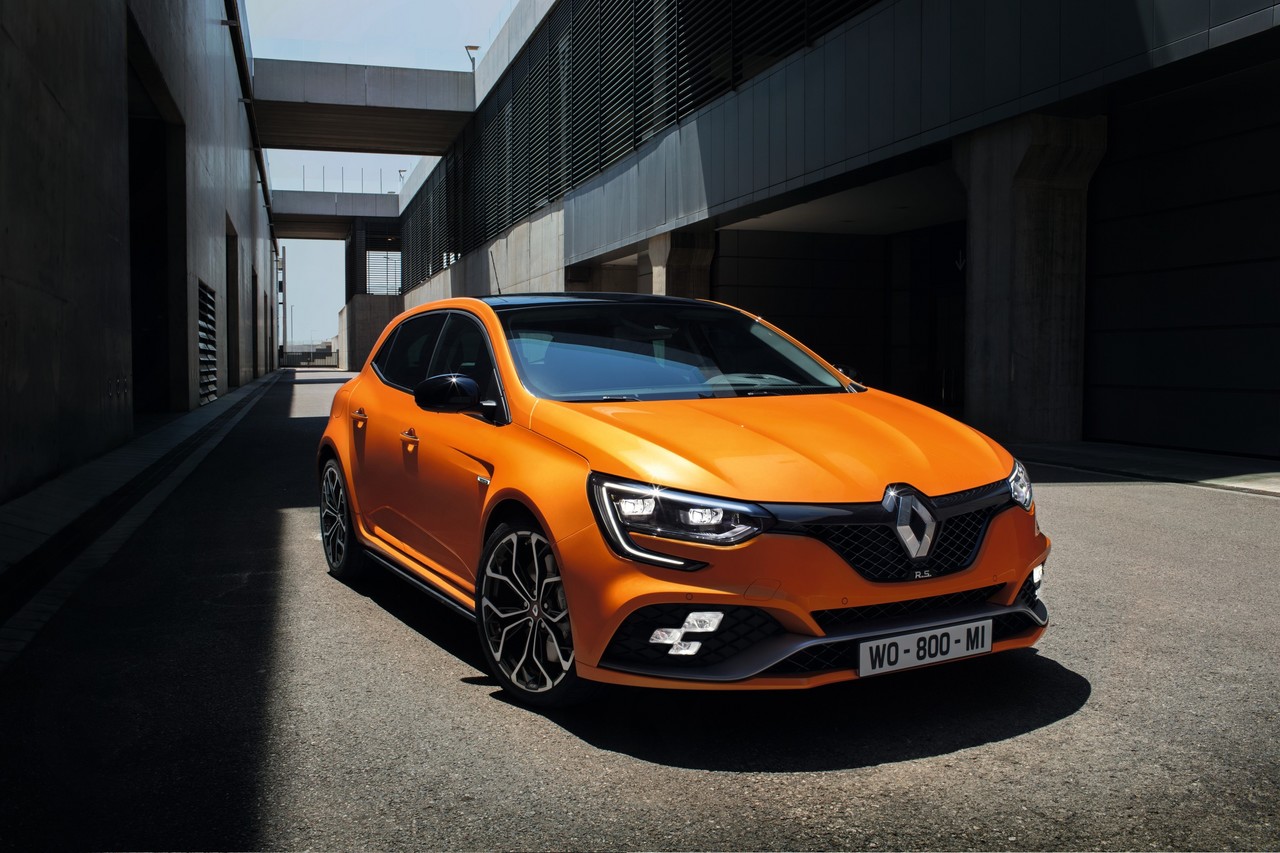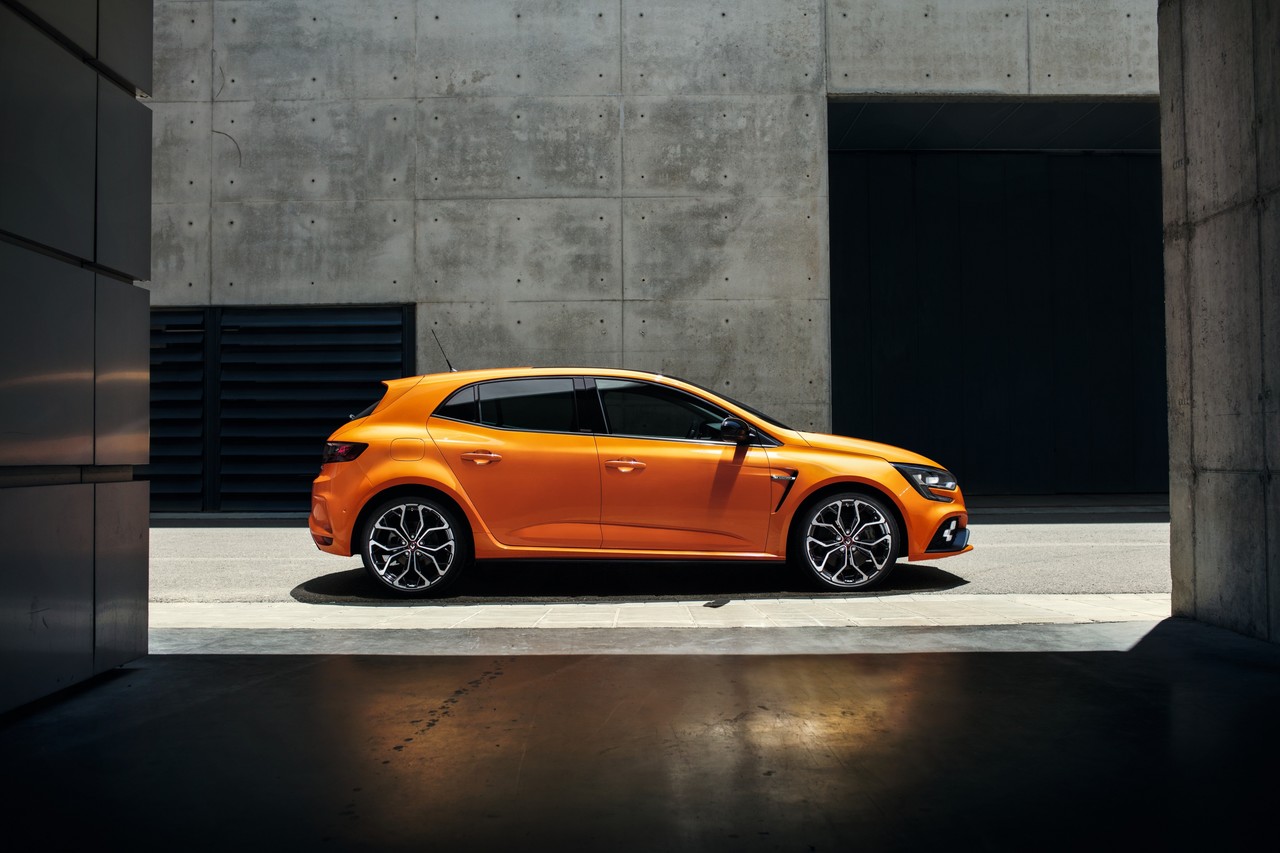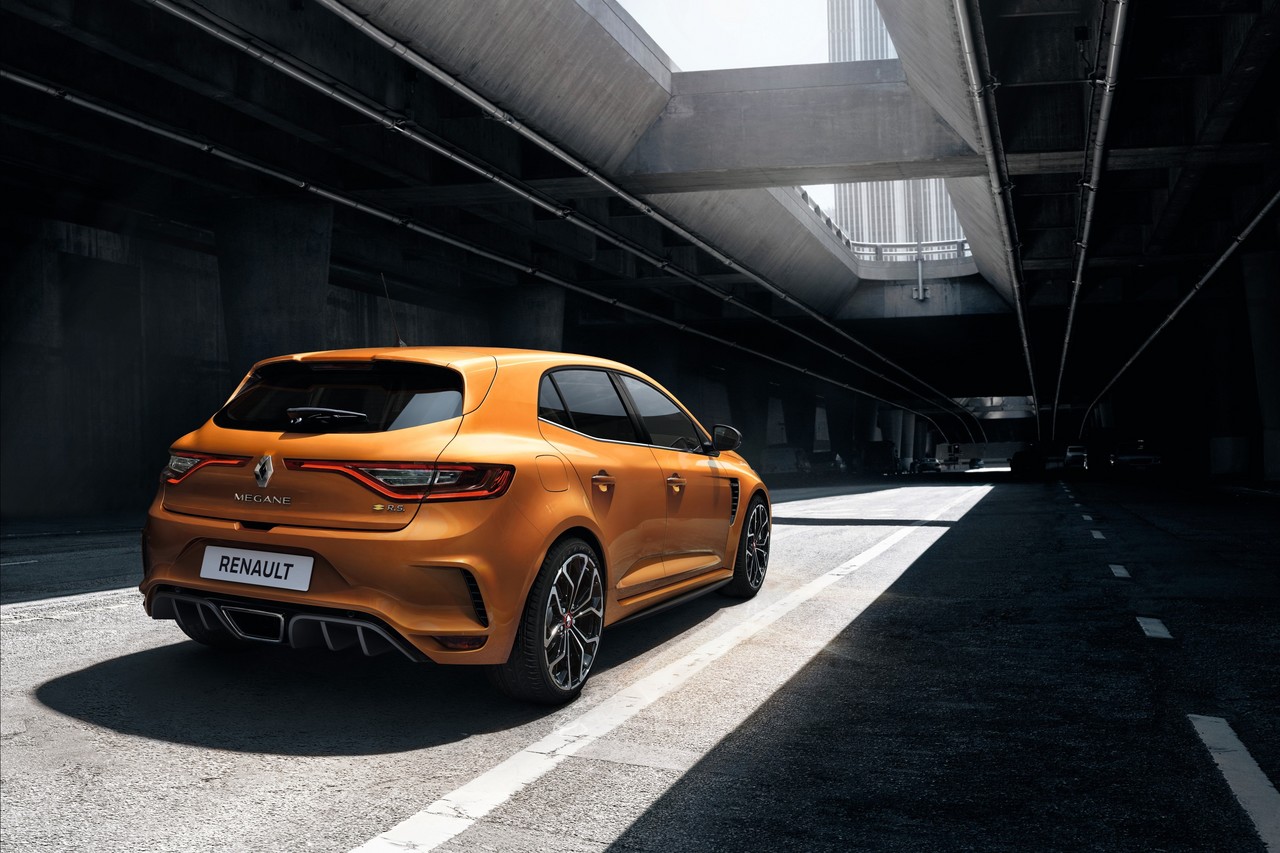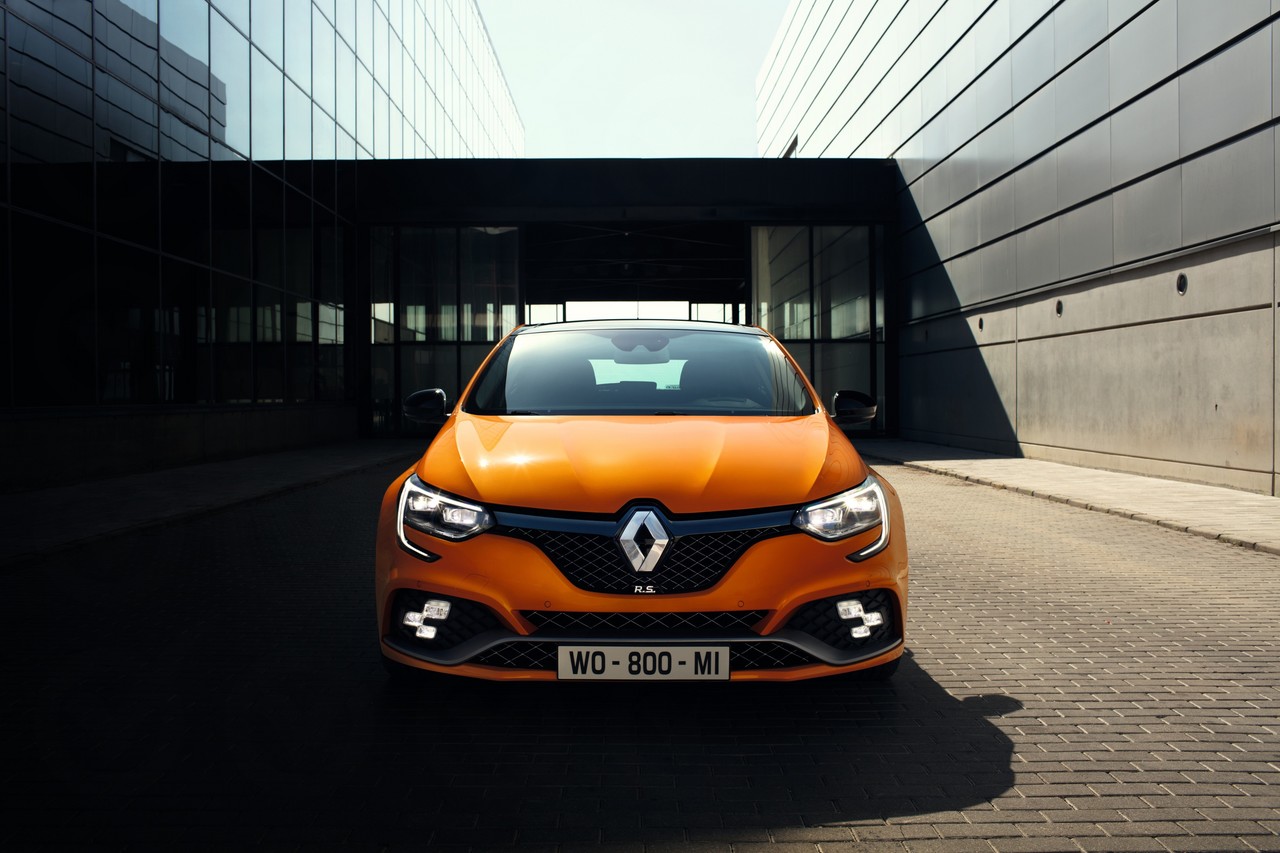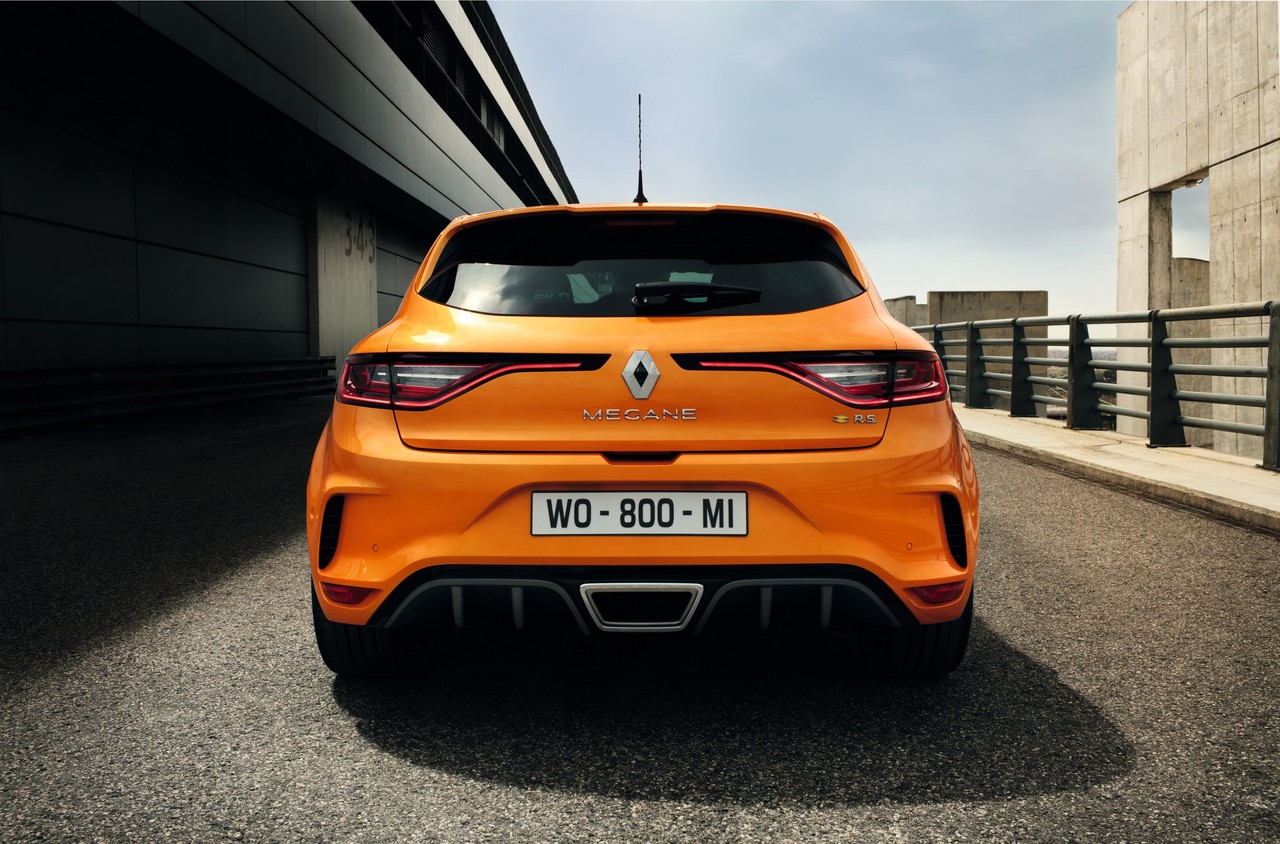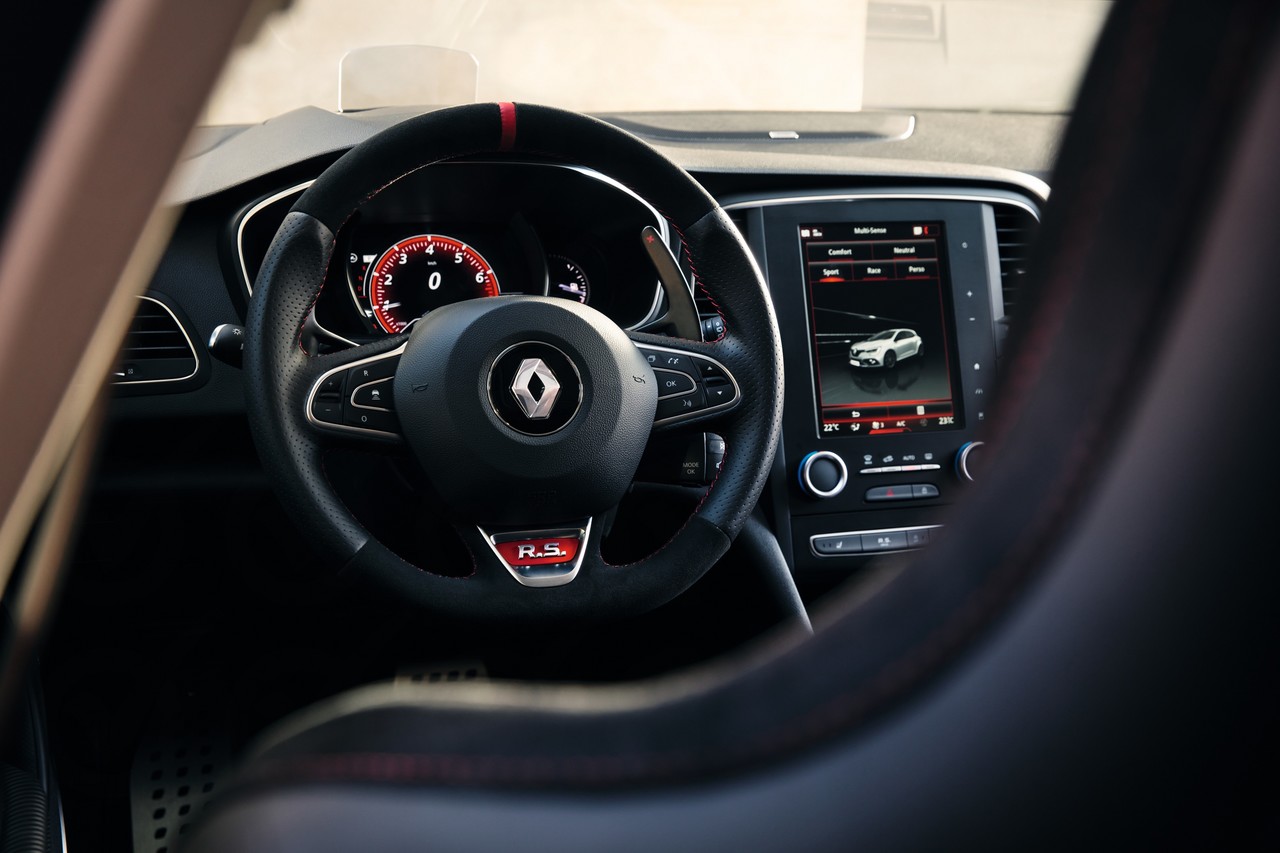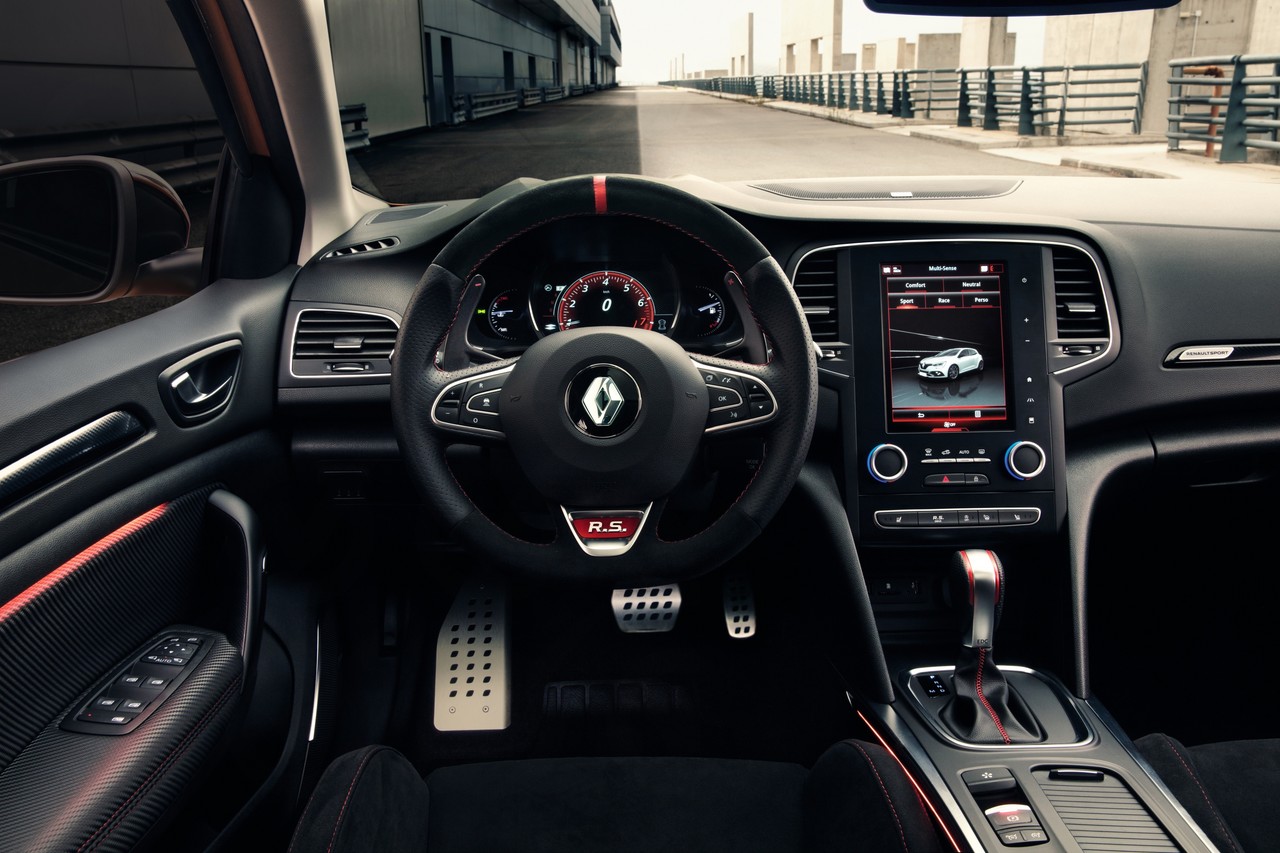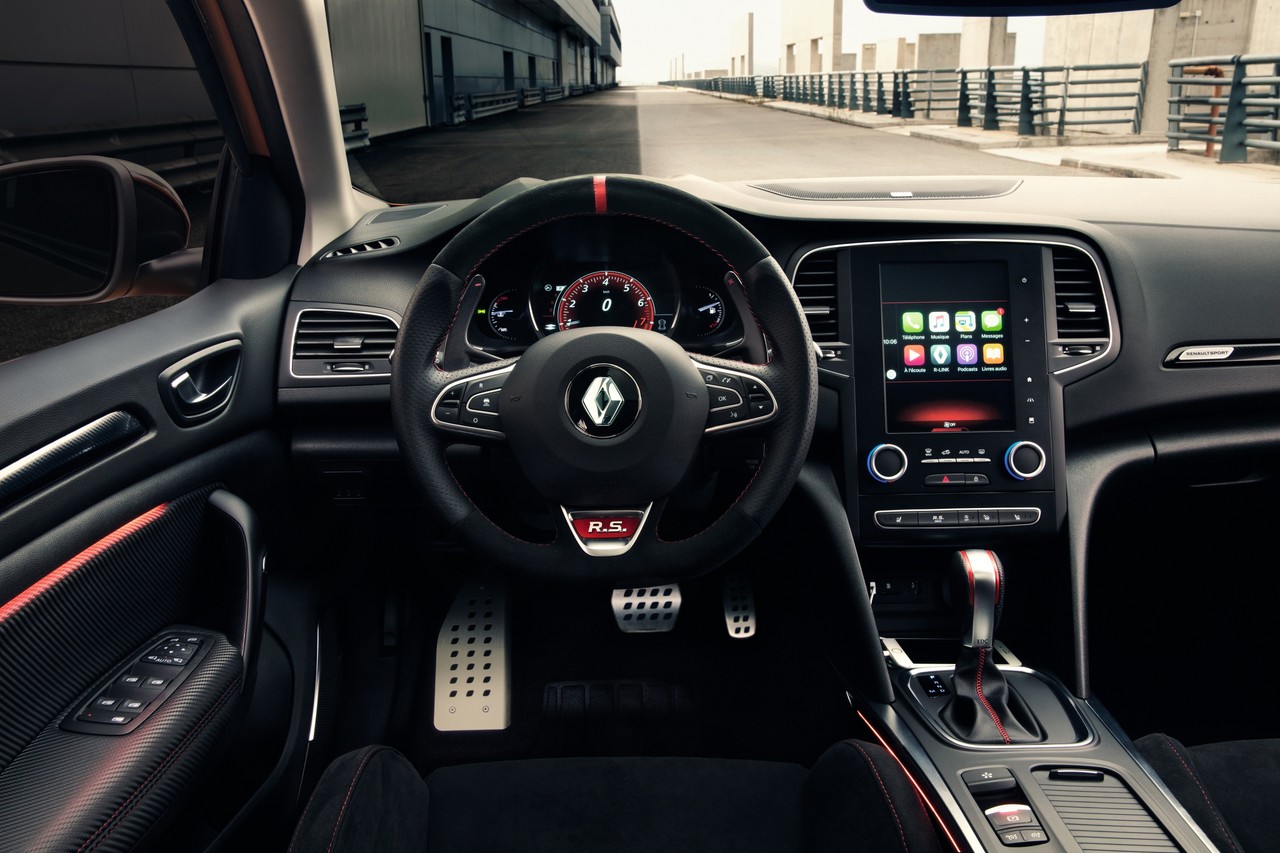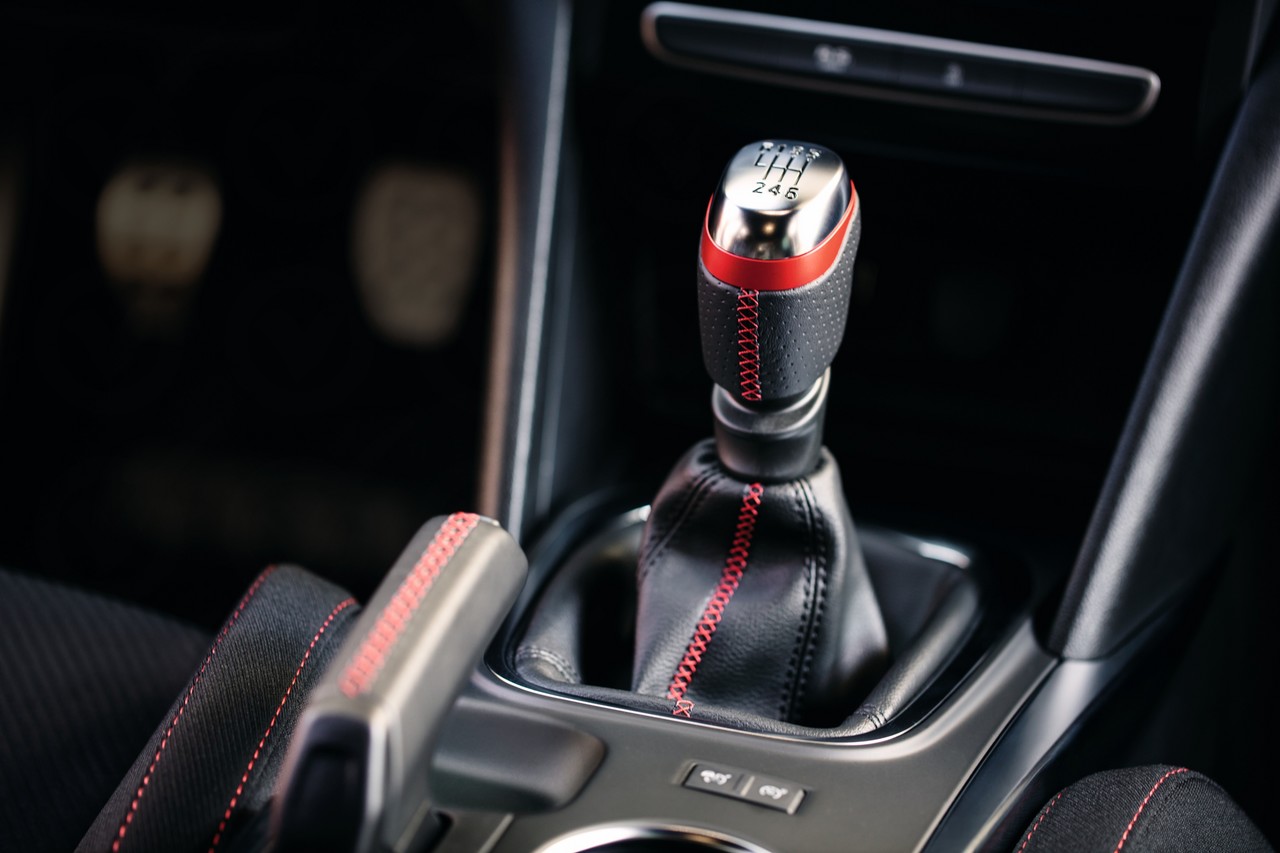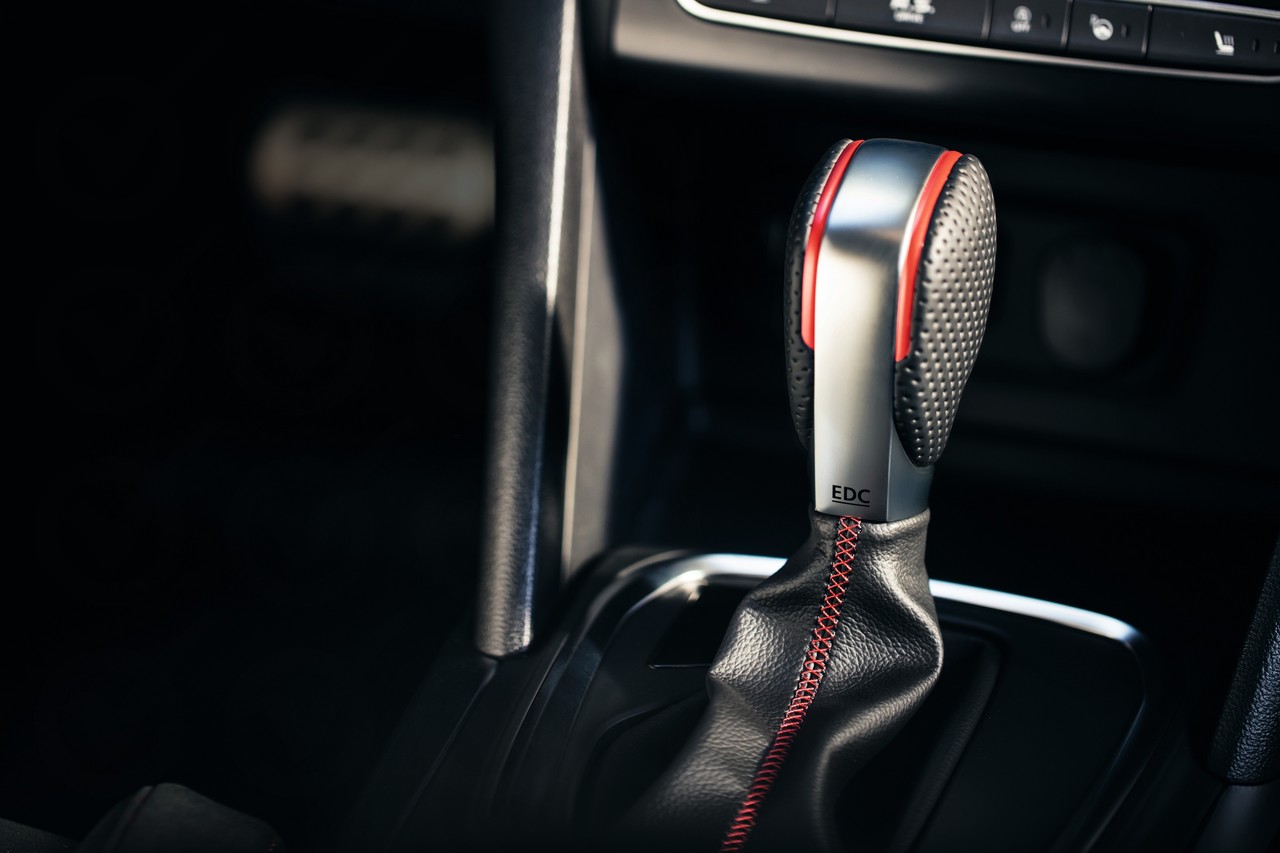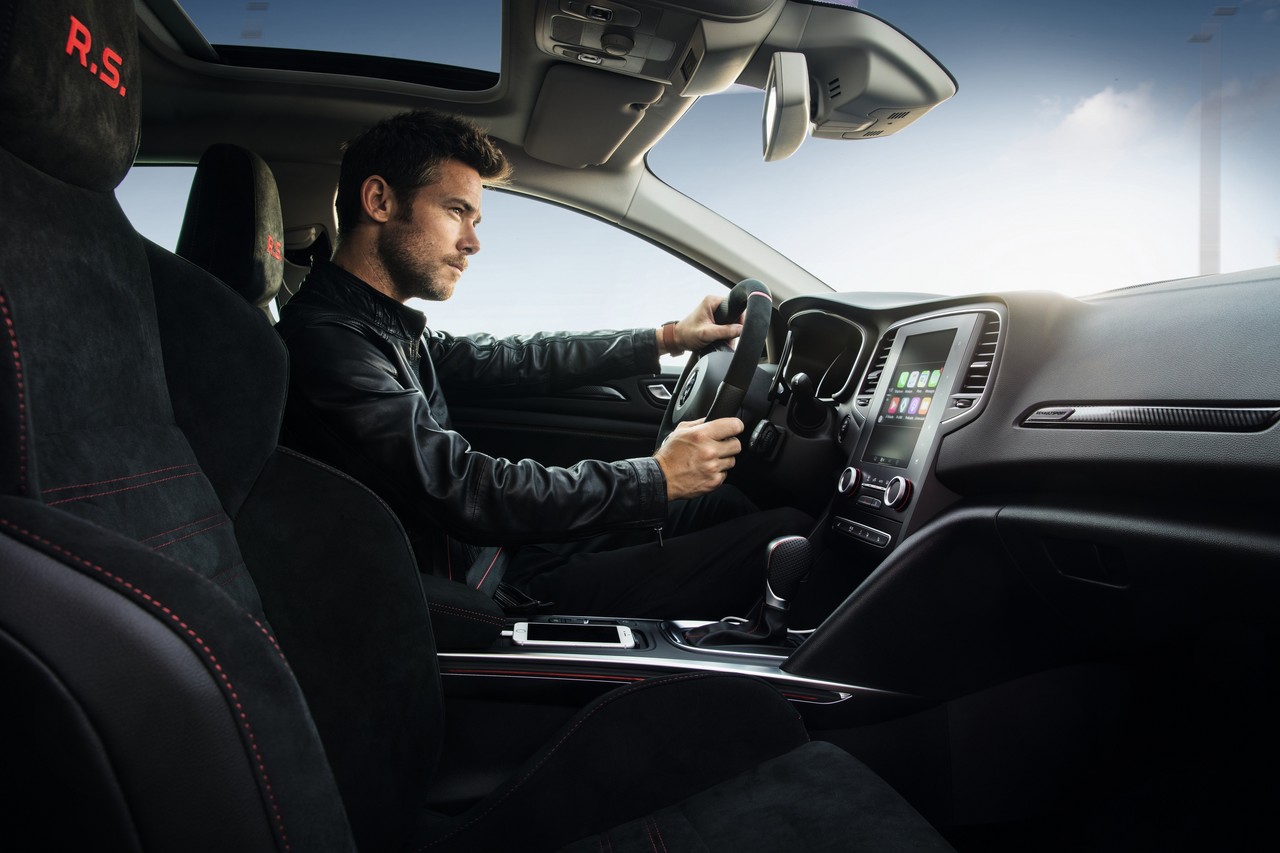
- Steering is accurate, well-weighted and provides good feel
- Surprisingly supple and class-leading ride
- Supportive front sports seats
- Four-wheel steering improves manoeuvrability
- Manual transmission works well and has good pedal position
- For Megane RS EDC, poor positioning and action for gear shift paddles. Also, gearshifts lack refinement and automatic shifts are not always well timed
- Throttle response and engine note fall short of class leaders
- Mismatch of analogue and digital instruments
Overview
Released in Australia in September 2018, the Renault BFB Megane RS was a five-door hot hatch. Manufactured in Palencia, Spain, the front-wheel drive Renault BFB Megane RS was powered by a 1.8-litre turbocharged petrol engine that was mated to either six-speed manual or double clutch (Renault’s ‘Efficient Dual Clutch’ or EDC) transmissions.
Renault Megane RS: M5PT engine
Developed by the Renault-Nissan Alliance, the transversely-mounted M5PT engine had 79.7 mm bores – which featured a Mirror Bore Coating for the cylinder sleeves – and a stroke of 90.1 mm for a capacity of 1798 cc. Other features of the M5PT engine included its aluminium alloy block and cylinder head, double overhead camshafts (chain driven), four valves per cylinder with a Diamond-like Carbon (DLC) coating for the valve lifters, variable intake and exhaust valve timing, twin-scroll turbocharger, electronically controlled wastegate and direct fuel injection.
The M5PT engine required 98 RON premium unleaded petrol. Over the combined ADR 81/02 test cycle, fuel consumption for the BFB Megane RS was 7.4 and 7.5 litres per 100 km with the manual and EDC transmissions, respectively.
Shared with the Alpine A110 , AustralianCar.Reviews understands that the M5PT engine was produced in the Renault Samsung Motors plant in Busan, South Korea.
| Variant | Engine | Trans. | Peak power | Peak torque |
|---|---|---|---|---|
| Sport | 1798 cc turbo petrol I4 | 6sp man., 6sp EDC |
205 kW at 6000 rpm | 390 Nm at 2400 rpm |
| Cup | 1798 cc turbo petrol I4 | 6sp man., 6sp EDC (2019-on) |
205 kW at 6000 rpm | 390 Nm at 2400 rpm |
| Trophy | 1798 cc turbo petrol I4 | 6sp man. | 221 kW at 6000 rpm | 400 Nm at 3200 rpm |
| 6sp EDC | 221 kW at 6000 rpm | 420 Nm at 3200 rpm | ||
| Trophy-R | 1798 cc M5Pt | 6sp EDC | 221 kW at 6000 rpm | 400 Nm at 3200 rpm |
Dimensions and body
Compared to the Renault X95 Megane RS , the Renault BFB Megane RS was 73 mm longer (at 4372 mm), 26 mm wider (1874 mm), 10 mm taller (1445 mm) and had a 23 mm longer wheelbase (2669 mm); boot capacity was 434 litres, though this increased to 1247 litres when the rear seats were folded down and luggage was filled to the roofline. Styling cues for the BFB Megane RS included its F1-style front blade, 3D honeycomb-pattern grille mesh and rear diffusor.
The Renault Megane RS had an unladen kerb weight of 1427 kg and 1450 kg with manual and EDC transmissions, respectively.
Suspension
Like the Renault BFB Megane hatch , the BFB Megane RS had MacPherson strut front suspension and a torsion beam rear axle. Compared to the Megane RS 280 Sport, the Cup chassis had 25 per cent firmer shock absorbers, 30 per cent tighter springs and 10 per cent stiffer anti-roll bars. Furthermore, the suspension of the Renault Megane RS has four hydraulic compression bump stops. According to Renault, the hydraulic bump stops acted as a secondary shock absorber to dampen wheel movement as the end of travel approached.
Steering and 4CONTROL
The Renault BFB Megane RS had rack-and-pinion steering with electric power assistance. The BFB Megane RS was also equipped with Renault’s ‘4CONTROL’ four-wheel steering system. At speeds up to 60 km/h (or 100 km/h in Race mode), 4CONTROL would turn the rear wheels in the opposite direction to the front wheels – by up to 2.7 degrees – for a smaller turning radius. At speeds above 60 km/h (or 100 km/h in Race mode), however, the rear wheels would turn in the same direction as the front wheels – by up to 1.0 degree – for greater stability.
Safety equipment
Standard safety equipment for the Renault BFB Megane RS included dual front airbags, front seat-mounted side airbags, full-length curtain airbags, ABS, electronic brake force distribution, brake assist, electronic stability control, traction control and front seatbelts with pre-tensioners and load limiters.
As standard, the Renault BFB Megane RS was equipped with the following active safety technologies –
- Advanced Emergency Braking System (AEBS, Inter-urban): operating at speeds between 30 km/h and 140 km/h, AEBS would warn the driver if there was a collision risk with the vehicle ahead. If the driver failed to respond or did not react sufficiently, the brakes would be applied autonomously to avoid or reduce the severity of a collision;
- Safe Distance Warning (DW): operating at speeds between 30 km/h and 200 km/h, a warning pictogram – which corresponded to the time interval separating the Megane RS from the vehicle ahead – would be displayed in the in the instrument cluster;
- Adaptive Cruise Control (ACC): operating at speeds between 50 km/h and 140 km/h, ACC used a front radar sensor to measure the distance to the vehicle ahead and would automatically adjust vehicle speed to maintain a pre-selected distance;
- Lane Departure Warning (LDW): operating at speeds above 70 km/h, LDW would alert the driver if the Megane RS crossed a solid or broken white line without the indicators having been previously activated; and,
- Blind Spot Warning (BSW): operating at speeds between 30 km/h and 140 km/h, BSW would warn the driver of the presence of another vehicle in the driver’s blind spot via a visual signal in the door mirrors.
Euro NCAP crash testing
In Euro NCAP testing , a left-hand drive 2015 Renault BFB Megane hatch received a five star safety rating which included an 88 per cent adult occupant protection rating and an 87 per cent child occupant protection rating. In the frontal offset test, occupant protection was generally rated as good, though lower leg protection for the front passenger and lower right leg protection for the driver were rated as adequate (i.e. a slight risk of serious injury). Maximum points were awarded in the side impact test; in the more severe pole test, however, chest protection was rated as adequate.
Wheels, tyres and brakes
The Renault Megane RS had 8.5J x 19-inch ‘Interlagos’ diamond-cut alloy wheels with 245/35 R19 tyres. Rather than a spare wheel, however, the Megane RS had a tyre repair kit.
The Renault Megane RS had 355 mm by 28 mm ventilated front brake discs with Brembo callipers and 290 mm by 11 mm solid rear discs. For the Megane RS Cup with manual transmission, the front brake discs were produced from aluminium and cast iron to reduce the weight per wheel by 1.8 kg.
Features: 2018 Renault Megane RS
As standard, the Renault Megane RS was equipped with Renault’s ‘R-Link 2’ navigation and multimedia system which had an 8.7-inch capacitive touchscreen (portrait orientation), a ‘3D Sound by Arkamys’ audio system with eight speakers, a 3.5 mm auxiliary input, two USB inputs, Bluetooth mobile phone connectivity with audio streaming, voice recognition and smartphone integration (via Apple CarPlay and Android Auto).
Beyond this, standard features for the Megane RS included front sports seats with integrated headrests, dual-zone climate control air conditioning, cruise control, dusk-sensing headlights, rain-sensing wipers, 60:40 split and folding rear seats, remote central locking with Renault’s ‘Smart Key Card’, power mirrors with electric demisting, power windows, a height and reach adjustable steering wheel finished in nappa leather, height adjustable front seats, an auto-dimming rear-view mirror, push-button start, 12 volt power sockets (front and rear), tyre pressure monitoring, a digital instrument cluster, rear privacy glass, a trip computer and an immobiliser. Furthermore,
- Renault’s ‘R.S. Vision’ LED lighting signature – which consisted of which ‘Pure Vision’ LED headlights, LED front fog lights and daytime running lights – provided three power intensities and three different functionalities: fog/cornering lights, high beam and low beam. According to Renault, ‘R.S. Vision’ enhanced night-time visibility by co-ordinating the fog lights, cornering lights, side lights and long-range headlights;
- Renault’s ‘MultiSense’ system enabled the driver to select from five drive modes: Comfort, Normal, Sport, Race and Personal. Using the ‘R-Link 2’ table, driver aids could be activated or switched off; and,
- The ‘RS Monitor’ telemetry system included an ‘Expert’ mode that allowed users to connect a camera, film their drive, play back and analyse their data, and share their images on social media.
For models with the EDC transmission, the Megane RS also had steering wheel gearshift paddles, a launch control function and electronic parking brake.
Megane RS models with the Cup Pack were further equipped with a mechanical Torsen Limited Slip Differential (LSD) –
- During deceleration, the differential has a transfer rate of 25 per cent; and,
- During acceleration, the differential has a transfer rate of 45 per cent.
May 2019 update
From May 2019, the Renault Megane RS Sport EDC and Cup (manual and EDC) models were equipped with a Bose audio system and combination Alcantara/leather seat trim as standard.
Renault Megane RS Trophy
Released in Australia in late 2019, the Renault Megane RS Trophy had the same suspension as the Megane RS Cup and, similarly, was fitted with a mechanical Torsen limited slip differential. However, the Megane RS Trophy was fitted with 19-inch ‘Jerez’ alloy wheels, Bridgestone Potenza S001 tyres and had bi-material front brake discs.
For the Renault Megane RS Trophy, the turbocharger had ceramic ball bearings which reduced friction by two-thirds compared to steel ball bearings. Furthermore, the exhaust silencer was fitted with a mechanical valve that enabled engine noise to be adjusted according to the Multi-Sense mode selected. When the valve was shut, exhaust gases were routed along a path that was designed to reduce low frequencies that caused throbbing noises. When the valve was open, the reduced flow resistance enabled the gases to be routed along a more direct path.
Australian deliveries of the Megane RS Trophy were limited to one hundred vehicles.
Renault Megane RS Trophy-R
The Renault Megane RS Trophy-R was sold in Australia in July 2019, but the delivery of twenty vehicles only occurred in early 2020. The Megane RS Trophy-R had the same engine as the Megane RS Trophy, but was 130 kg lighter due to the following measures:
- A carbon composite bonnet which weighed 8 kg (a reduction of 8 kg). Carbon was used for the NACA air intake in the bonnet lining, while the remainder was fibreglass;
- A carbon rear diffuser;
- 19-inch ‘Fuji’ alloy wheels that were 2 kg lighter per wheel;
- An Akrapovic titanium exhaust (a reduction of 6 kg);
- A lighter, non-directional rear axle (a reduction of 38 kg);
- A high performance DESS (Dual Energy Storage System) lead battery;
- Sabelt composite monocoque racing seats coated with Alcantara (a reduction of 7 kg per seat);
- A holding subframe rather than a rear seat (a reduction of 25.3 kg);
- Thin glassine, sealed rear door windows and omission of the rear window wiper; and,
- A seven-inch multimedia screen (a reduction of 250 grams).
As such, the Megane RS Trophy-R could accelerate from rest to 100 km/h in 5.4 seconds and had a top speed of 262 km/h
Other enhancements for the Renault Megane RS Trophy-R included:
- Increased negative camber for the front wheels (-2.05 degrees, an increase of 1 degree);
- Adjustable Ohlins shock absorbers;
- Brembo four-piston 42 mm front brake callipers;
- Bridgestone Potenza S007 tyres;
- Redesigned bottom blade under the front bumper for improved aerodynamic balance; and,
- Fairings under the front bumper and under the chassis to improve air flow to the rear diffuser.
Brochure and Specifications
- Brochure: Renault BFB Megane RS (August)
- Specifications: Renault BFB Megane RS (July 2018)
- Features and Equipment: Renault BFB Megane RS (September 2018)
Related links
